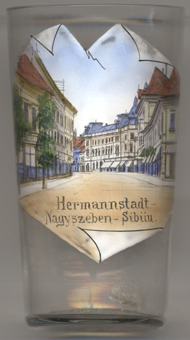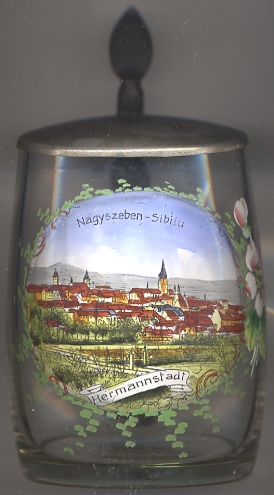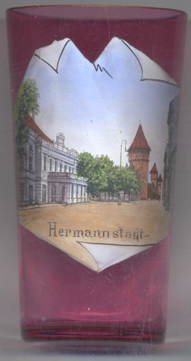

|
| ROMÂNIA | ROMANIA |
| județ Sibiu | Sibiu County |
 Sibiu is situated at an elevation of 415 m on the Cibin river, some 215 km northwest of Bucharest.
Now the capital of Sibiu County, between 1692 and 1791 and 1849-1865 Sibiu was the capital of the Principality of Transylvania
and the centre of the Transylvanian Saxons.
Sibiu is one of the most important cultural centres of Romania and, in tandem with the city of Luxembourg), it was designated a
European Capital of Culture for the year 2007.
The city also administers the Păltiniș, although that village lies on territory that is not contiguous with the city of Sibiu itself.
The municipality of Sibiu has a population of about 147,250 (2011).
Sibiu is situated at an elevation of 415 m on the Cibin river, some 215 km northwest of Bucharest.
Now the capital of Sibiu County, between 1692 and 1791 and 1849-1865 Sibiu was the capital of the Principality of Transylvania
and the centre of the Transylvanian Saxons.
Sibiu is one of the most important cultural centres of Romania and, in tandem with the city of Luxembourg), it was designated a
European Capital of Culture for the year 2007.
The city also administers the Păltiniș, although that village lies on territory that is not contiguous with the city of Sibiu itself.
The municipality of Sibiu has a population of about 147,250 (2011).
 The first official record referring to the Sibiu area comes from 1191, when Pope Celestine III confirmed the existence of the free prepositure of the German settlers in
Transylvania, the prepositure having its headquarters in Sibiu, named Cibinium at that time. In the 14th century, it was already an important trade center.
Sibiu became the most important ethnic German city among the 'seven cities' that gave Transylvania its German name Siebenbürgen (literally 'seven cities'):
Broos (Orăștie, Szászváros), Großschenk (Cincu, Nagysink), Mühlbach (Sebeș, Szászsebes),
Leschkirch (Nocrich, Újegyház), Reps (Rupea, Kőhalom), Reußmarkt (Miercurea Sibiului, Szerdahely) and
Schäßburg (Sighișoara, Segesvár), plus Hermannstadt (Sibiu, Nagyszeben) being the main town.
Sibiu (Hermannstadt) was also home to the 'Universitas Saxorum', the assembly of Germans in Transylvania.
During the 18th and 19th centuries, the city became the second and later the first most important center of Transylvanian Romanian ethnics.
After the Romanian Orthodox Church was granted status in the Habsburg Empire from the 1860s onwards, Sibiu became the Metropolitan seat, and the city is still regarded as the
third-most important center of the Romanian Orthodox Church. Between the Hungarian Revolution of 1848 and 1867, Sibiu was the meeting-place of the Transylvanian Diet, which
had taken its most representative form after the Empire agreed to extend voting rights in the region. After World War I, when Austria-Hungary was dissolved, Sibiu became part
of Romania; the majority of its population was still ethnic German (until 1941) and counted a large Romanian community, as well as a small Hungarian one. Starting from the 1950s
and until after 1990, most of the city's ethnic Germans emigrated to Germany.
The first official record referring to the Sibiu area comes from 1191, when Pope Celestine III confirmed the existence of the free prepositure of the German settlers in
Transylvania, the prepositure having its headquarters in Sibiu, named Cibinium at that time. In the 14th century, it was already an important trade center.
Sibiu became the most important ethnic German city among the 'seven cities' that gave Transylvania its German name Siebenbürgen (literally 'seven cities'):
Broos (Orăștie, Szászváros), Großschenk (Cincu, Nagysink), Mühlbach (Sebeș, Szászsebes),
Leschkirch (Nocrich, Újegyház), Reps (Rupea, Kőhalom), Reußmarkt (Miercurea Sibiului, Szerdahely) and
Schäßburg (Sighișoara, Segesvár), plus Hermannstadt (Sibiu, Nagyszeben) being the main town.
Sibiu (Hermannstadt) was also home to the 'Universitas Saxorum', the assembly of Germans in Transylvania.
During the 18th and 19th centuries, the city became the second and later the first most important center of Transylvanian Romanian ethnics.
After the Romanian Orthodox Church was granted status in the Habsburg Empire from the 1860s onwards, Sibiu became the Metropolitan seat, and the city is still regarded as the
third-most important center of the Romanian Orthodox Church. Between the Hungarian Revolution of 1848 and 1867, Sibiu was the meeting-place of the Transylvanian Diet, which
had taken its most representative form after the Empire agreed to extend voting rights in the region. After World War I, when Austria-Hungary was dissolved, Sibiu became part
of Romania; the majority of its population was still ethnic German (until 1941) and counted a large Romanian community, as well as a small Hungarian one. Starting from the 1950s
and until after 1990, most of the city's ethnic Germans emigrated to Germany.
The  Lutheran Cathedral of Saint Mary [centre background] is the most famous Gothic-style church in Sibiu. Its massive 73.34 m
high steeple is a landmark of the city. The four turrets situated on top of the steeple were a sign to let foreigners know that the town had the right to sentence to death.
was built in the 14th century on the location of another 12th-century church. For three centuries it served as a burial place for the mayors, earls and other personalities from Sibiu.
This practice was banned in 1796 but one exception was made in 1803 when baron Samuel von Brukenthal, governor of the Grand Principality of Transylvania 1774–1787, was laid
to rest in the crypt. In 1671 a Slovakian craftsman built an organ to replace the previous one that was built in 1585. The 17th century organ case is still preserved; the organ itself
was replaced by a modern instrument in 1914 by the famous Wihelm Sauer organbuilding company. Today, the organ is the largest in the southeastern region of Europe.
Lutheran Cathedral of Saint Mary [centre background] is the most famous Gothic-style church in Sibiu. Its massive 73.34 m
high steeple is a landmark of the city. The four turrets situated on top of the steeple were a sign to let foreigners know that the town had the right to sentence to death.
was built in the 14th century on the location of another 12th-century church. For three centuries it served as a burial place for the mayors, earls and other personalities from Sibiu.
This practice was banned in 1796 but one exception was made in 1803 when baron Samuel von Brukenthal, governor of the Grand Principality of Transylvania 1774–1787, was laid
to rest in the crypt. In 1671 a Slovakian craftsman built an organ to replace the previous one that was built in 1585. The 17th century organ case is still preserved; the organ itself
was replaced by a modern instrument in 1914 by the famous Wihelm Sauer organbuilding company. Today, the organ is the largest in the southeastern region of Europe.

The  Carpenters' Tower [near left, no. 3630: background right]
was built in 1337–1366 as part of the third ring of fortifications, the towers of which were named for various
trade guilds that were in charge of defending that part of the town walls against the turks. The octogonal upper part
was added around 1450. In the far background right, one can see two further towers, the
Carpenters' Tower [near left, no. 3630: background right]
was built in 1337–1366 as part of the third ring of fortifications, the towers of which were named for various
trade guilds that were in charge of defending that part of the town walls against the turks. The octogonal upper part
was added around 1450. In the far background right, one can see two further towers, the
 Potters'
Potters' Crossbow-makers'
Crossbow-makers'
The  Thalia Theatre [left] was built in 1787–1788 as
Municipal Theatre (Stadttheather) within the walls of the 'Thick Tower'. In 1904 it was rebuilt.
Known als as Deutsches Theater ('German Theatre'), it was later renamed Teatrul Orasenesc and
Sala Thalia. Renovated in 2004, it has 800 seats and is used as a concert hall and home of the
"Filarmonicii de Stat" orchestra.
Thalia Theatre [left] was built in 1787–1788 as
Municipal Theatre (Stadttheather) within the walls of the 'Thick Tower'. In 1904 it was rebuilt.
Known als as Deutsches Theater ('German Theatre'), it was later renamed Teatrul Orasenesc and
Sala Thalia. Renovated in 2004, it has 800 seats and is used as a concert hall and home of the
"Filarmonicii de Stat" orchestra.
The German name of Sibiu, Hermannstadt, is similar to the former
German name of Heřmanův Městec (CZ), Hermannstädtel.
[http://en.wikipedia.org/wiki/Sibiu, https://de.wikipedia.org/wiki/Hermannstadt;
http://en.wikipedia.org/wiki/Sibiu_Lutheran_Cathedral, http://en.wikipedia.org/wiki/Samuel_von_Brukenthal,
http://hermannstadt.evang.ro/stadtpfarrkirche/sauer-orgel/;
https://de.wikipedia.org/wiki/Zimmermannsturm_(Hermannstadt), https://7buergen.eu/4-00-spaziergang-durch-alt-hermannstadt/4-47-die-hartenecktuerme/]
![[scale]](lineal.jpg)